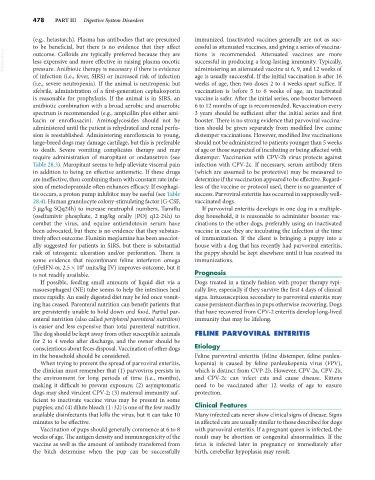Page 506 - Small Animal Internal Medicine, 6th Edition
P. 506
478 PART III Digestive System Disorders
(e.g., hetastarch). Plasma has antibodies that are presumed immunized. Inactivated vaccines generally are not as suc-
to be beneficial, but there is no evidence that they affect cessful as attenuated vaccines, and giving a series of vaccina-
VetBooks.ir outcome. Colloids are typically preferred because they are tions is recommended. Attenuated vaccines are more
successful in producing a long-lasting immunity. Typically,
less expensive and more effective in raising plasma oncotic
pressure. Antibiotic therapy is necessary if there is evidence
age is usually successful. If the initial vaccination is after 16
of infection (i.e., fever, SIRS) or increased risk of infection administering an attenuated vaccine at 6, 9, and 12 weeks of
(i.e., severe neutropenia). If the animal is neutropenic but weeks of age, then two doses 2 to 4 weeks apart suffice. If
afebrile, administration of a first-generation cephalosporin vaccination is before 5 to 6 weeks of age, an inactivated
is reasonable for prophylaxis. If the animal is in SIRS, an vaccine is safer. After the initial series, one booster between
antibiotic combination with a broad aerobic and anaerobic 6 to 12 months of age is recommended. Revaccination every
spectrum is recommended (e.g., ampicillin plus either ami- 3 years should be sufficient after the initial series and first
kacin or enrofloxacin). Aminoglycosides should not be booster. There is no strong evidence that parvoviral vaccina-
administered until the patient is rehydrated and renal perfu- tion should be given separately from modified live canine
sion is reestablished. Administering enrofloxacin to young, distemper vaccinations. However, modified live vaccinations
large-breed dogs may damage cartilage, but this is preferable should not be administered to patients younger than 5 weeks
to death. Severe vomiting complicates therapy and may of age or those suspected of incubating or being affected with
require administration of maropitant or ondansetron (see distemper. Vaccination with CPV-2b virus protects against
Table 28.3). Maropitant seems to help alleviate visceral pain infection with CPV-2c. If necessary, serum antibody titers
in addition to being an effective antiemetic. If these drugs (which are assumed to be protective) may be measured to
are ineffective, then combining them with constant rate infu- determine if the vaccination appeared to be effective. Regard-
sion of metoclopramide often enhances efficacy. If esophagi- less of the vaccine or protocol used, there is no guarantee of
tis occurs, a proton pump inhibitor may be useful (see Table success. Parvoviral enteritis has occurred in supposedly well-
28.4). Human granulocyte colony-stimulating factor (G-CSF, vaccinated dogs.
5 µg/kg SQq24h) to increase neutrophil numbers, Tamiflu If parvoviral enteritis develops in one dog in a multiple-
(oseltamivir phosphate, 2 mg/kg orally [PO] q12-24h) to dog household, it is reasonable to administer booster vac-
combat the virus, and equine antiendotoxin serum have cinations to the other dogs, preferably using an inactivated
been advocated, but there is no evidence that they substan- vaccine in case they are incubating the infection at the time
tively affect outcome. Flunixin meglumine has been anecdot- of immunization. If the client is bringing a puppy into a
ally suggested for patients in SIRS, but there is substantial house with a dog that has recently had parvoviral enteritis,
risk of iatrogenic ulceration and/or perforation. There is the puppy should be kept elsewhere until it has received its
some evidence that recombinant feline interferon omega immunizations.
6
(rFeIFN-ω, 2.5 × 10 units/kg IV) improves outcome, but it
is not readily available. Prognosis
If possible, feeding small amounts of liquid diet via a Dogs treated in a timely fashion with proper therapy typi-
nasoesophageal (NE) tube seems to help the intestines heal cally live, especially if they survive the first 4 days of clinical
more rapidly. An easily digested diet may be fed once vomit- signs. Intussusception secondary to parvoviral enteritis may
ing has ceased. Parenteral nutrition can benefit patients that cause persistent diarrhea in pups otherwise recovering. Dogs
are persistently unable to hold down oral food. Partial par- that have recovered from CPV-2 enteritis develop long-lived
enteral nutrition (also called peripheral parenteral nutrition) immunity that may be lifelong.
is easier and less expensive than total parenteral nutrition.
The dog should be kept away from other susceptible animals FELINE PARVOVIRAL ENTERITIS
for 2 to 4 weeks after discharge, and the owner should be
conscientious about feces disposal. Vaccination of other dogs Etiology
in the household should be considered. Feline parvoviral enteritis (feline distemper, feline panleu-
When trying to prevent the spread of parvoviral enteritis, kopenia) is caused by feline panleukopenia virus (FPV),
the clinician must remember that (1) parvovirus persists in which is distinct from CVP-2b. However, CPV-2a, CPV-2b,
the environment for long periods of time (i.e., months), and CPV-2c can infect cats and cause disease. Kittens
making it difficult to prevent exposure; (2) asymptomatic need to be vaccinated after 12 weeks of age to ensure
dogs may shed virulent CPV-2; (3) maternal immunity suf- protection.
ficient to inactivate vaccine virus may be present in some
puppies; and (4) dilute bleach (1 : 32) is one of the few readily Clinical Features
available disinfectants that kills the virus, but it can take 10 Many infected cats never show clinical signs of disease. Signs
minutes to be effective. in affected cats are usually similar to those described for dogs
Vaccination of pups should generally commence at 6 to 8 with parvoviral enteritis. If a pregnant queen is infected, the
weeks of age. The antigen density and immunogenicity of the result may be abortion or congenital abnormalities. If the
vaccine as well as the amount of antibody transferred from fetus is infected later in pregnancy or immediately after
the bitch determine when the pup can be successfully birth, cerebellar hypoplasia may result.

